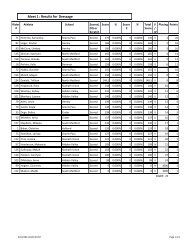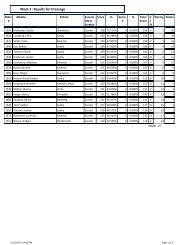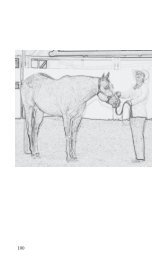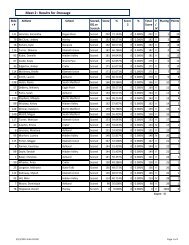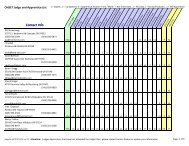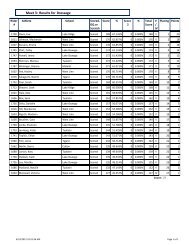Timed Events - Oregon High School Equestrian Team
Timed Events - Oregon High School Equestrian Team
Timed Events - Oregon High School Equestrian Team
Create successful ePaper yourself
Turn your PDF publications into a flip-book with our unique Google optimized e-Paper software.
104
Stalnackers.com<br />
105
28. <strong>Timed</strong> <strong>Events</strong>, General Rules<br />
28.1. Required Equipment<br />
28.1.1. Bridle or Hackamore<br />
28.1.2. Western type saddle with horn<br />
28.1.3. Roping, Romal, or Mecate reins<br />
28.2. Prohibited Equipment<br />
28.2.1. Halters<br />
28.2.2. Split Reins<br />
28.2.3. Chaps, ½ Chaps, or Chinks<br />
28.2.4. Lariat Ropes<br />
28.3. Optional Equipment<br />
28.3.1. Slip or gag bits<br />
28.3.2. Nose bands<br />
28.3.3. Spurs<br />
28.3.4. Protective boots, leg wraps, and bandages<br />
28.3.5. Over and Under<br />
28.3.5.1. May be inspected by the judge<br />
28.3.6. Tie-Downs<br />
28.3.6.1. Attached to or under breast collar<br />
28.3.6.2. Fitted properly as to not be a danger if equine falls or<br />
athlete loses control (at judge’s discretion)<br />
28.3.7. Martingales<br />
28.3.7.1. Fitted properly as to not be a danger if equine falls or<br />
athlete loses control (at judge’s discretion)<br />
28.3.7.2. Rein Stops are required on Running Martingales<br />
28.3.8. Ribbons, paint, glitter and speed beads<br />
28.4. Timing<br />
28.4.1. An Electronic-Eye type timer will be used if at all possible<br />
28.4.1.1. All events will be measured and recorded to the<br />
hundredths place only (16.01). Thousandths place (16.010)<br />
will be dropped with NO rounding.<br />
28.5. Setting and Re-Setting the Course<br />
28.5.1. It is the judge’s responsibility to oversee, supervise and<br />
participate in all course set up<br />
28.5.2. In NO event will the course be reset during a team or individual<br />
run<br />
28.6. Arena Safety<br />
28.6.1. As soon as possible, after athlete enters the arena, ALL gates are<br />
to be closed and remain closed until athlete has completed their<br />
“run.”<br />
28.6.1.1. Running in the gate is NOT allowed and will be<br />
considered an elimination/No time<br />
28.6.1.2. Gate does not have to be closed for athlete to start<br />
28.6.2. Athletes must enter and leave the arena demonstrating control<br />
28.6.3. ONLY athletes on course, coaches, advisors, ring crew and<br />
officials are allowed in the arena during an event.<br />
106
28.6.4. Equine that constitute a safety hazard may be eliminated.<br />
28.6.5. NO athletes may be coached from inside the arena during an<br />
event.<br />
28.7. On Course<br />
28.7.1. Is defined as starting when the athlete crosses the start line<br />
28.7.2. Ends with the athlete crosses the finish line<br />
28.8. Re-Rides<br />
28.8.1. May be awarded at Judge’s Discretion<br />
28.8.1.1. Including, but not limited to:<br />
28.8.1.1.1. In the event both the official and the back-up timers<br />
fail<br />
28.8.2. No penalties will be carried over<br />
28.8.3. All new penalties will apply<br />
28.8.4. Re-Rides will be ridden at the bottom of the order for that event<br />
28.8.5. Rider must request a re-ride immediately<br />
28.9. Eliminations – Participation point awarded<br />
28.9.1. Running in the arena and onto the course<br />
28.9.2. Leaving the course, run outs, refusals, upsetting the starting<br />
poles<br />
28.9.3. Upsetting timers or start poles<br />
28.9.4. Failure to keep at least one hand on the reins, except when<br />
momentarily dropping them<br />
28.9.5. Taking more than 30 seconds to cross the starting line.<br />
28.9.5.1. The 30 seconds starts after the announcer has announced<br />
the athlete and the judge raises their hand with a closed fist<br />
indicating the course is ready.<br />
28.9.6. Fall of the rider while on course<br />
28.9.7. Dismounting at any time while on course (except in <strong>Team</strong><br />
Canadian Flags)<br />
28.9.8. Loss of control or an unmanageable equine<br />
28.9.9. Off Course<br />
28.9.9.1. Off Course will be defined as:<br />
28.9.9.1.1. Not following the prescribed pattern<br />
28.9.9.1.2. All 4 feet past any obstacle on the wrong side<br />
(except Key Race, where any part on the line or past<br />
the neck is a No Time)<br />
28.9.9.1.3. Circling any part of the course before crossing the<br />
start line<br />
28.10. Disqualifications – NO POINTS Awarded<br />
28.10.1. Intentionally striking the equine with arena equipment<br />
28.10.2. Abuse or inhumane treatment as determined by the judge<br />
28.10.3. Unsportsmanlike or disorderly conduct in the arena<br />
28.10.3.1. Including use of profane language<br />
28.10.4. If an athlete/team enters the arena with missing required<br />
equipment illegal equipment, or illegal use of permitted<br />
107
equipment, including uniform violations, not considered unsafe,<br />
the athlete/team will be allowed to continue on the course and<br />
receive scores and comments but will be disqualified from the<br />
event.<br />
28.10.5. Obvious lameness or unsoundness detected in participating<br />
equine.<br />
28.11. Course Records<br />
28.11.1. There are no ties; the record must be broken for it to be a new<br />
course record.<br />
28.11.2. The course will immediately be measured and may not be<br />
more than 8” short in overall length.<br />
28.11.2.1. In the Keyhole race, the course cannot be more than 4”<br />
over the correct width of the neck, or 4” shorter than the<br />
correct length of neck.<br />
28.11.3. The electronic time will be accepted as official as long as the<br />
manual time supports it.<br />
28.11.3.1. At judge’s and official timer’s discretion<br />
28.11.4. If the electronic time fails and the manual back up time is a<br />
record,<br />
28.11.4.1.1. The manual time may be used for class placing,<br />
but NOT as a “record”<br />
28.11.4.1.1.1. The athlete has a choice to use the manual<br />
time<br />
28.11.4.1.1.1.1. No Record<br />
28.11.4.1.1.1.2. Receives Class Placing, based on<br />
manual time<br />
28.11.4.1.1.2. The athlete may choose a Re-Ride<br />
28.11.4.1.1.2.1. If a re-ride is chosen, all re-ride rules<br />
apply<br />
28.11.4.1.1.2.2. Once the re-ride begins (the athlete<br />
attempts to enter the arena) the athlete<br />
is committed to using the re-ride time.<br />
They may no longer choose to take their<br />
original time.<br />
28.11.5. The athlete holding the best time in the State is deemed the<br />
State Record Holder, whether course is run at a district or state<br />
meet.<br />
28.11.6. Records will be tracked for all events in each District and State<br />
Championship.<br />
28.11.7. Record is to be confirmed in writing by the official timer and<br />
the judge utilizing the <strong>Timed</strong> Event Record Form.<br />
28.11.7.1. This form should then be forwarded to the State Points<br />
Chair immediately following the meet.<br />
28.11.7.2. All timed event record forms should be sent in to the<br />
State Points Chair, even if the record is broke again during<br />
the same event.<br />
108
29. Individual <strong>Events</strong><br />
29.1. Texas Barrels<br />
29.1.1. Penalties<br />
29.1.1.1. Knocking over any barrel is a 5 second penalty<br />
29.1.2. Equipment<br />
29.1.2.1. Two Start Poles/cones<br />
29.1.2.2. Barrels<br />
29.1.2.2.1. Plastic Barrel with rimmed bottom 30 to 35 pounds<br />
29.1.3. Set Up<br />
29.1.3.1. There is a 60’ Start/Finish Line<br />
29.1.3.2. Three barrels shall be placed in a triangular formation<br />
29.1.3.3. No. 1 and No. 2 barrels are set 33’ from the start/finish<br />
line and 60’ apart<br />
29.1.3.4. No. 3 barrel is 80’ from No. 1 and No. 2 barrels (See<br />
Diagram)<br />
29.1.4. Prescribed Pattern<br />
29.1.4.1. Rider crosses starting line, circles RIGHT barrel to right<br />
or LEFT barrel to left, then circles opposite barrel in<br />
opposite direction, then rides to MIDDLE barrel (3rd) and<br />
turns it the same direction as their second barrel, then races<br />
across finish line (See diagram)<br />
29.1.5. Diagram<br />
109
110<br />
29.2. Figure 8<br />
29.2.1. Penalties<br />
29.2.1.1. Knocking over either end pole is a 5 second penalty<br />
29.2.1.2. Circling any part of the course before crossing the start<br />
line is a No Time<br />
29.2.1.3. Athletes may start from either end of the course<br />
29.2.1.3.1. Still only have 30 seconds to cross start line from<br />
the time the course is ready or No Time<br />
29.2.2. Equipment<br />
29.2.2.1. Four Poles with bases<br />
29.2.2.1.1. Black rubber base, 14 pounds, 6” tall, 14” across;<br />
total weight, pole and converter, approximately 16<br />
pounds
29.2.2.1.2. Poles to be white with two 3” red or blue stripes.<br />
First is 1’ from the top and the 2nd one foot down<br />
from the first stripe.<br />
29.2.3. Set Up<br />
29.2.3.1. Two poles set 120’ apart at opposite ends of the course<br />
29.2.3.2. Two center poles (set at half way mark), set 30’ apart<br />
29.2.3.2.1. Center poles are the start/finish line<br />
29.2.4. Prescribed Pattern<br />
29.2.4.1. Rider Starts between two center poles and runs a figure<br />
8 around the two poles. (one turn to the left and one to the<br />
right)<br />
29.2.4.2. First turn (direction) is optional<br />
29.2.5. Diagram<br />
111
112<br />
29.3. Individual Flags<br />
29.3.1. Penalties<br />
29.3.1.1. Failure to switch flags and place them in the appropriate<br />
cans, in the correct order, and go around second barrel will<br />
result in a penalty.<br />
29.3.1.1.1. Flag (or flag ends of staff) must be in the correct<br />
cans when athlete crosses the finish line for NO<br />
penalties.<br />
29.3.1.1.2. A flag that falls out of the barrel after the athlete<br />
has crossed the finish line will NOT be penalized.<br />
29.3.1.1.3. A flag that misses the 3rd barrel (1st barrel), or is<br />
carried over the start finish line will be a 5 second<br />
penalty.<br />
29.3.1.1.4. Failure to place the first flag in the second barrel<br />
will be an elimination<br />
29.3.1.2. All barrels must remain standing at the end of the run.<br />
Failure to do this will be an elimination.<br />
29.3.2. Equipment<br />
29.3.2.1. Two Start Poles<br />
29.3.2.2. Two ¼ barrels (containers)<br />
29.3.2.2.1. Painted White<br />
29.3.2.3. Two Flags<br />
29.3.2.3.1. One 1 1/16” diameter staff (doweling) – fir or<br />
hemlock<br />
29.3.2.3.2. Five feet (5’) long, painted white<br />
29.3.2.3.3. Tapered at the bottom to a dull point<br />
29.3.2.3.4. Flags to be sturdy cotton, double thickness,<br />
hemmed, Eight inches by twelve inches (8” x 12”)<br />
29.3.2.3.4.1. One white and one dark<br />
29.3.2.3.4.2. Wrapped completely around the staff,<br />
leaving an eight inch by eight inch (8” x 8” )<br />
portion free from the staff<br />
29.3.3. Set Up<br />
29.3.3.1. Two starting poles, 30’ apart<br />
29.3.3.2. Two containers placed 100’ apart at opposite ends of the<br />
course<br />
29.3.3.2.1. Each container will contain 8-10 inches of soil<br />
29.3.3.3. First container is 20’ from the start line<br />
29.3.4. Prescribed Pattern<br />
29.3.4.1. Athlete crosses starting line, goes to first container taking<br />
that flag out<br />
29.3.4.2. then while going around the second barrel, exchanges the<br />
flags<br />
29.3.4.3. returns to the first container and places the flag from the<br />
second container into the first container
29.3.4.4. then crosses the finish line.<br />
29.3.5. Diagram<br />
29.4. Keyhole<br />
29.4.1. Penalties<br />
29.4.1.1. Stepping on, or outside any line of the keyhole is an NO<br />
TIME<br />
29.4.1.2. Any part of the hoof past the entrance of the key hole<br />
neck is a NO TIME<br />
29.4.1.2.1. This “neck” line continues across the arena<br />
29.4.2. Equipment<br />
29.4.2.1. Two starting poles, 30’ apart<br />
29.4.2.2. A keyhole marked with lime (or similar substance)<br />
113
114<br />
29.4.3. Set Up<br />
29.4.3.1. The neck of the keyhole begins 80’ from start line in<br />
center of line – see diagram<br />
29.4.3.1.1. The neck is five feet ( 5’ ) wide<br />
29.4.3.1.2. The neck is ten feet (10’) long<br />
29.4.3.2. Circle is 20’ diameter<br />
29.4.4. Prescribed Pattern<br />
29.4.4.1. Athlete crosses the start/finish line, races into the circle<br />
of the keyhole (completely clearing the neck with all 4<br />
hooves)<br />
29.4.4.2. Turns horse 180 degrees either direction<br />
29.4.4.3. Run out and across the start/finish line<br />
29.4.5. Diagram
29.5. Pole Bending<br />
29.5.1. Penalties<br />
29.5.1.1. Each pole knocked down is a 5 second penalty<br />
29.5.2. Equipment<br />
29.5.2.1. Two starting poles, 30’ apart<br />
29.5.2.2. Six (6) additional poles with bases<br />
29.5.2.2.1. Poles to be white, between 1” and 1 1/2” PVC pipe<br />
29.5.2.2.2. The same diameter of pole will be used for each<br />
event.<br />
29.5.2.2.3. Poles at the state meet will be 1 1/2”<br />
29.5.2.2.4. Schedule 40 or 80<br />
29.5.2.2.5. Eighty to eighty one (80-81) inches long<br />
29.5.2.2.6. with two 3” red or blue stripes. First is 1’ from<br />
the top and the second one foot down from the first<br />
stripe. (striping is optional)<br />
29.5.2.3. Plastic converter (bushing) to be used to secure pole in<br />
base either by a cotter-key or glue<br />
29.5.2.4. Black rubber base, 14 pounds, 6” tall, 14” across;<br />
29.5.2.5. Total weight, including base, pole and converter,<br />
approximately 16 pounds<br />
29.5.3. Set Up<br />
29.5.3.1. Six poles shall be set in a straight line, beginning from<br />
the middle of the start poles, spaced 21’ apart with the<br />
start/finish line 21’ from the first pole<br />
29.5.4. Prescribed Pattern<br />
Rich Mosier, DVM Chris Camp, DVM Brett Lemhouse, DVM Kathy Connell, DVM<br />
Del Oeste Equine Hospital<br />
115
116<br />
29.5.4.1. The athlete crosses the start/finish line, races to pole #6<br />
(last pole in the line)<br />
29.5.4.2. Then bends back through the poles,<br />
29.5.4.3. Completely turning pole #1 (closest to start poles)<br />
29.5.4.4. Then bends back toward pole #6<br />
29.5.4.5. Turns final pole and races straight across start/finish line<br />
29.5.5. Diagram
30. <strong>Team</strong> <strong>Events</strong><br />
30.1. Eliminations<br />
30.1.1. <strong>Team</strong>s will be eliminated if any horse waiting its turn crosses<br />
the start/finish line before the horse on course crosses the start/<br />
finish line completely. There may not be two horses on course at<br />
any time.<br />
30.1.2. Unsafe passing. <strong>Team</strong>s are encouraged to, but not required to<br />
pass (one coming off the course, one going on the course) on<br />
opposite ends of the start line. However, a pass deemed unsafe<br />
by the judge, may be cause for elimination<br />
30.2. Two Man Bi-Rangle<br />
30.2.1. Penalties<br />
30.2.1.1. Knocking over either pole is a 5 second penalty<br />
30.2.2. Equipment<br />
30.2.2.1. Four Poles with bases<br />
30.2.2.1.1. Black rubber base, 14 pounds, 6” tall, 14” across;<br />
total weight, pole and converter, approximately 16<br />
pounds<br />
30.2.2.1.2. Poles to be white with two 3” red or blue stripes.<br />
First is 1’ from the top and the 2nd one foot down<br />
from the first stripe.<br />
30.2.3. Set Up<br />
30.2.3.1. Two start poles set 30’ apart<br />
30.2.3.2. A center line will be identified at the start/finish line,<br />
approximately 10’ long extending to the off course side<br />
and perpendicular to the start/finish line.<br />
30.2.3.3. Two poles set 30’ apart, 120’ down the arena from start/<br />
finish line<br />
30.2.4. Prescribed Pattern<br />
30.2.4.1. First athlete races down the course,<br />
30.2.4.2. turns either pole from the inside out,<br />
30.2.4.3. then turns the opposite pole from the outside in (either 2<br />
left or 2 right turns)<br />
30.2.4.4. then races back across the start/finish line<br />
30.2.4.5. Then the 2nd athlete runs the course,<br />
30.2.4.5.1. They may turn either direction first – they do not<br />
need to turn the same direction as the first rider<br />
30.2.5. Diagram<br />
117
Right Turns<br />
Left Turns<br />
Finish<br />
Start<br />
Start<br />
Finish<br />
Dimensions<br />
30'<br />
120'<br />
30'<br />
118<br />
OHSET<br />
Two Man Bi-Rangle<br />
Revised 11.4.11<br />
Note: Chalk, flour, or lime should<br />
be used to mark the spots when<br />
measuring. Center of Poles should<br />
be placed directly over spot.<br />
30.3. <strong>Team</strong> Canadian Flags<br />
30.3.1. Four athlete team event<br />
30.3.1.1. If a school has only 3 riding athletes (total on the school<br />
team, not just in flags), they may ride this event with 3<br />
athletes, using four equine.<br />
30.3.1.2. The holder of the 4th horse should be a coach, advisor, or<br />
athlete in boots or hard-soled shoes<br />
30.3.2. Penalties<br />
30.3.2.1. Not carrying your flag over the start/finish line will result<br />
in an Elimination
30.3.2.2. The horse and athlete must remain on the same side of the<br />
start/finish line while mounting and dismounting, moving<br />
or landing on the opposite side before completely being<br />
mounted will result in a NO TIME<br />
30.3.2.3. Not completely turning your flag (or the spot where it<br />
started) will result in a NO TIME<br />
30.3.3. Equipment<br />
30.3.3.1. Two start poles/cones<br />
30.3.3.2. Four 42” staffs with small alternately colored flags (flags<br />
are required, color is optional)<br />
30.3.3.2.1. Flag portion after being wrapped around staff will<br />
be eight inches by eight inches (8” x 8”)<br />
30.3.4. Set Up<br />
30.3.4.1. Two start poles set 30’ apart<br />
30.3.4.2. A center line will be identified at the start/finish line,<br />
approximately 10’ long extending to the off course side<br />
and perpendicular to the start/finish line.<br />
30.3.4.3. Four flags shall be on the centerline of the course,<br />
with the first flag set 100’ from start/finish line, and the<br />
remainder of the flags set at 2’ intervals. This means the<br />
fourth flag will be 106’ from the start/finish line<br />
30.3.5. Prescribed Pattern<br />
30.3.5.1. First athlete races down the course,<br />
30.3.5.2. Turns the last flag (farthest from the start/finish line)<br />
either direction<br />
30.3.5.3. Picking up the last flag while turning and races back<br />
across the start finish line carrying the flag<br />
30.3.5.4. Remaining riders follow the same action, each taking<br />
the farthest flag in line, until all riders have completed the<br />
course<br />
30.3.5.5. Any rider may turn either direction<br />
30.3.5.6. Each rider must pick up their “assigned” flag in order<br />
30.3.5.7. Any flag knocked over must be picked up by the<br />
corresponding rider during their turn<br />
30.3.5.7.1. Riders may dismount and mount in order to pick<br />
up flags<br />
30.3.6. Diagram<br />
119
Right Turn<br />
Left Turn<br />
Start<br />
Finish<br />
Finish<br />
Start<br />
Dimensions<br />
106'<br />
104'<br />
102'<br />
100'<br />
30'<br />
OHSET<br />
<strong>Team</strong> Canadian Flags<br />
Revised 11.4.11<br />
Note: Chalk, flour, or lime should<br />
be used to mark the spots when<br />
measuring. Center of Poles should<br />
be placed directly over spot.<br />
120
390 WEST 11 TH<br />
EUGENE OREGON 97401<br />
(541) 344-3218<br />
MICHELIN BRIDGESTONE COOPER<br />
COMMERCIAL RETREADING<br />
PASSENGER – RV’S – TRUCKS<br />
COMMERCIAL ALL SIZES<br />
Wyatt’s Tires<br />
Mahindra All Seasons Equipment<br />
121



